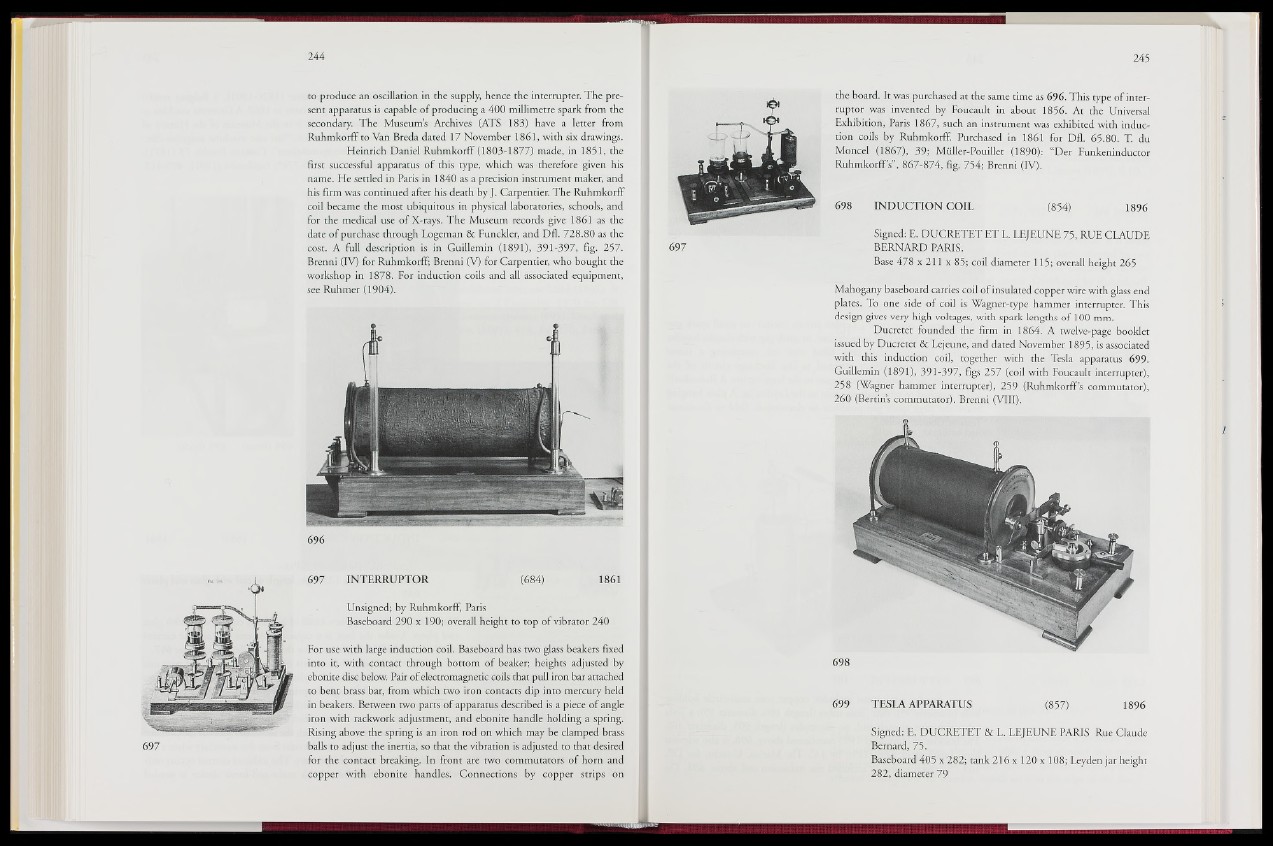
to produce an oscillation in the supply, hence the interrupter. The present
apparatus is capable of producing a 400 millimetre spark from the
secondary. The Museums Archives (ATS 183) have a letter from
Ruhmkorff to Van Breda dated 17 November 1861, with six drawings.
Heinrich Daniel Ruhmkorff (1803-1877) made, in 1851, the
first successful apparatus of this type, which was therefore given his
name. He settled in Paris in 1840 as a precision instrument maker, and
his firm was continued after his death by J. Carpentier. The Ruhmkorff
coil became the most ubiquitous in physical laboratories, schools, and
for the medical use of X-rays. The Museum records give 1861 as the
date of purchase through Logeman & Funckler, and Dfl. 728.80 as the
cost. A full description is in Guillemin (1891), 391-397, fig. 257.
Brenni (IV) for Ruhmkorff; Brenni (V) for Carpentier, who bought the
workshop in 1878. For induction coils and all associated equipment,
see Ruhmer (1904).
697 INTERRUPTOR (684) 1861
Unsigned; by Ruhmkorff, Paris
Baseboard 290 x 190; overall height to top of vibrator 240
For use with large induction coil. Baseboard has two glass beakers fixed
into it, with contact through bottom of beaker; heights adjusted by
ebonite disc below. Pair of electromagnetic coils that pull iron bar attached
to bent brass bar, from which two iron contacts dip into mercury held
in beakers. Between two parts of apparatus described is a piece of angle
iron with rackwork adjustment, and ebonite handle holding a spring.
Rising above the spring is an iron rod on which may be clamped brass
balls to adjust the inertia, so that the vibration is adjusted to that desired
for the contact breaking. In front are two commutators of horn and
copper with ebonite handles. Connections by copper strips on
the board. It was purchased at the same time as 696. This type of interruptor
was invented by Foucault in about 1856. At the Universal
Exhibition, Paris 1867, such an instrument was exhibited with induction
coils by Ruhmkorff. Purchased in 1861 for Dfl. 65.80. T. du
Moncel (1867), 39; Miiller-Pouillet (1890): “Der Funkeninductor
Ruhmkorff s”, 867-874, fig. 754; Brenni (IV).
698 INDUCTION COIL (854) 1896
Signed: E. DUCRETET ET L. LEJEUNE 75, RUE CLAUDE
BERNARD PARIS.
Base 478 x 211 x 85; coil diameter 115; overall height 265
Mahogany baseboard carries coil of insulated copper wire with glass end
plates. To one side of coil is Wagner-type hammer interrupter. This
design gives very high voltages, with spark lengths of 100 mm.
Ducretet founded the firm in 1864. A twelve-page booklet
issued by Ducretet & Lejeune, and dated November 1895, is associated
with this induction co ll together with the Tesla apparatus 699.
Guillemin (1891), 391-39Mpgs 257 (coil with Foucault interrupter),
258 (Wagner hammer interrupter), 259 (Ruhmkorff s commutator),
260 (Bertins commutator). Brenni (VIII).
698
699 TESLA APPARATUS (857) 1896
Signed: E. DUCRETET & L. LEJEUNE PARIS Rue Claude
Bernard, 75.
Baseboard 405 x 282; tank 216 x 120 x 108; Leyden jar height
282, diameter 79